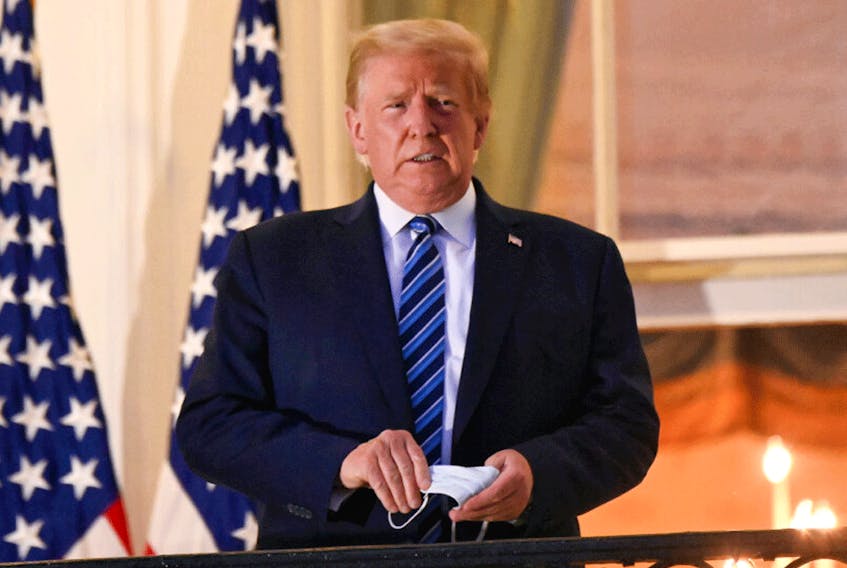Now is when it gets interesting.
The announcement Oct. 2 that United States President Donald Trump had fallen ill with COVID-19 hardly came as a surprise. His political strategy of playing down COVID-19 required him to be reckless about his own health, and other Republicans were already dropping like flies. Fourteen Republican Senators and Representatives have now tested positive as of this writing, compared to six Democrats.
Some journalists who were up against a deadline started speculating right away about what would happen if Trump died from COVID, but that felt kind of ghoulish. Besides, the odds were long against it.
“Feeling really good!” he tweeted. “Don’t be afraid of COVID! Don’t let it dominate your life!... I feel better than I did 20 years ago!”
The death rate for people in their 70s who are hospitalized with COVID symptoms is much higher than for younger people, but it’s still only 8.5 per cent. Being male and fat with a heart problem are all additional risk factors for Trump, but they are probably counterbalanced by the fact that he gets excellent medical care 24 hours a day. So, wait and see.
Wait how long? After a million deaths (almost a quarter of them in the United States), we now know a good deal about the pattern of this disease and it is rarely life-threatening in the first week after symptoms develop. Some suffer from a constant dry cough, fever, headache, fatigue, and/or a loss of the sense of smell and taste, but at worst there’s a certain shortness of breath.
We know that Trump was briefly put on oxygen last Friday and again last Saturday, but that does not mean he’s deathly ill. On the other hand, the fact that the doctors let him go home to the White House on Monday doesn’t mean they are hugely confident either.
Trump would have put immense pressure on the doctors to let him go, since that would let him do some macho posturing about having defeated the virus. They would have shrugged their shoulders and given in, because the real crisis was not due until later anyway.
Trump did indeed indulge in some major chest-beating when he got home. “Feeling really good!” he tweeted. “Don’t be afraid of COVID! Don’t let it dominate your life!... I feel better than I did 20 years ago!”
Well, of course he’s feeling better. He’s on a steroid high. His doctors have put him on dexamethasone, a steroid medication that is not normally given to patients who are non-critical.
(He’s also taking remdesivir, monoclonal antibodies, zinc, vitamin D, famotidine, melatonin and aspirin, but none of those makes you feel like Superman.)
The doctors doubtless told Trump that the real make-or-break time with COVID-19 is seven to 10 days after symptoms first develop, when some patients who have been feeling reasonably well suddenly go into a steep decline, with severe lung problems. That’s when you get put on the ventilator. But it probably didn’t register.
“Now I'm better, and maybe I'm immune,” he said at the White House. Then he took his mask off and, still highly contagious, walked back into the White House among the staff who were standing by inside. (Or to be more precise, those who were still standing at all. A dozen White House staff have already gone down with the disease.)
If Day 1 for Trump was Oct. 1, as his doctors say, then Days 7 to 10 were Thursday to Sunday this week. So, it’s now reasonable for us to discuss how those days might define the future of the presidential election, and perhaps of the United States. Tastefully, of course, and with no ghoulishness.
Outcome A: Trump dies. Probability: less than 10 per cent (see above). Consequence: Vice-President Mike Pence takes his place, and loses the election.
Outcome B: Trump gets very ill and is rehospitalized. He survives, but cannot resume the campaign. Probability: around 10 per cent. Consequence: Joe Biden wins the presidency with a margin big enough that Trump’s people cannot plausibly dispute it. Normal service is resumed, and Trump spends the rest of his life in court.
Outcome C: Trump recovers, and is back out campaigning within a week. Probability: more than 70 per cent. Consequence: he still loses the election (just look at the numbers), but he is fit and able to build on the foundations he has already laid and lead a campaign from the White House (not necessarily non-violent) to dispute the postal vote.
He is desperate enough, and ruthless enough, to comprehensively muddy the waters, possibly with the help of his carefully packed Supreme Court. Perhaps the United States becomes a banana republic, perhaps not.
And we must recognize the possibility that Outcome C in some form is already inevitable because Trump contracted COVID days earlier, concealed it, and is already safely past Day 10. In which case this entire drama is just pantomime.
Gwynne Dyer’s new book is “Growing Pains: The Future of Democracy (and Work).”








